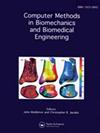Heart disease risk prediction based on deep learning multi-scale convolutional enhanced Swin Transformer model.
IF 1.6
4区 医学
Q3 COMPUTER SCIENCE, INTERDISCIPLINARY APPLICATIONS
Computer Methods in Biomechanics and Biomedical Engineering
Pub Date : 2025-09-05
DOI:10.1080/10255842.2025.2556004
引用次数: 0
Abstract
Heart disease is a leading global cause of death, making early prediction critical. This study proposes a multi-scale convolution-enhanced Swin Transformer (MSCST) model for heart disease risk assessment. The model employs a multi-branch convolutional network with channel attention to extract and optimize multi-scale features. These features are processed by a Swin Transformer module to integrate global and local information via self-attention. SHAP analysis is incorporated to enhance interpretability. Evaluated on the Cleveland Heart Disease dataset, MSCST achieved 89.42% accuracy and an AUC of 0.8908, outperforming both traditional machine learning and existing deep learning methods.
基于深度学习多尺度卷积增强Swin Transformer模型的心脏病风险预测。
心脏病是全球主要的死亡原因,因此早期预测至关重要。本研究提出了一种用于心脏病风险评估的多尺度卷积增强Swin变压器(MSCST)模型。该模型采用具有通道关注的多分支卷积网络对多尺度特征进行提取和优化。这些特征由Swin Transformer模块处理,通过自关注集成全局和局部信息。采用了SHAP分析来增强可解释性。在Cleveland Heart Disease数据集上进行评估,MSCST的准确率达到89.42%,AUC为0.8908,优于传统的机器学习和现有的深度学习方法。
本文章由计算机程序翻译,如有差异,请以英文原文为准。
求助全文
约1分钟内获得全文
求助全文
来源期刊
CiteScore
4.10
自引率
6.20%
发文量
179
审稿时长
4-8 weeks
期刊介绍:
The primary aims of Computer Methods in Biomechanics and Biomedical Engineering are to provide a means of communicating the advances being made in the areas of biomechanics and biomedical engineering and to stimulate interest in the continually emerging computer based technologies which are being applied in these multidisciplinary subjects. Computer Methods in Biomechanics and Biomedical Engineering will also provide a focus for the importance of integrating the disciplines of engineering with medical technology and clinical expertise. Such integration will have a major impact on health care in the future.

 求助内容:
求助内容: 应助结果提醒方式:
应助结果提醒方式:


